


Element B is a trademark of BCon/WSA International
Human Element Software System is a trademark of High Performing Systems, Inc.
| Click here to exit. Right click somewhere on the page (outside of an image) to print. |

|
|
| Organizational Interpretive Report | |
| Henry L. Thompson, Ph.D., and Will Schutz, Ph.D. | |
|
|
|
|
|
|

|

|
|
FIRO is a trademark of Consulting Psychologists Press, Inc. Element B is a trademark of BCon/WSA International Human Element Software System is a trademark of High Performing Systems, Inc. |
|
| Overview |
|
In 1958 Will Schutz, Ph.D., introduced the world to a theory of interpersonal
relations called FIRO (Fundamental Interpersonal Relations Orientation). The theory presented three dimensions of interpersonal relations
posited to be necessary and sufficient to explain most human interaction. On the behavioral level, these dimensions were called Inclusion,
Control and Affection. Dr. Schutz created an instrument, FIRO-B™, consisting of scales
that measure the behavioral aspects of the three dimensions. Over the years Schutz has expanded FIRO theory and developed
additional instruments for measuring the new aspects of the theory. These instruments have been extensively revised and simplified
since their introduction in 1984 (see Schutz, 1992). The theory has been so extensively revised and strengthened and has generated so many new instruments and important improvements, that at the suggestion of the publisher, Jack Black, the set of measures was renamed. Since 1984 it has been known as ELEMENTS of AWARENESS and the individual measures known as Element B: Behavior, Element F: Feelings, and so on (see Schutz, 1984 and 1992). |
| Element B |
|
Element B provides feedback on eighteen different aspects of interpersonal
behavior. It is based on Inclusion, Control and Openness (the concept that replaced Affection; see
Schutz, 1992 for explanation). Inclusion Inclusion has to do with IN and OUT. Inclusion is the area concerned with achieving the desired amount of contact with people. Sometimes people like a great deal of inclusion; they are outgoing, they enjoy doing things with a group and they tend to start conversations with strangers. At other times, people prefer to spend time alone. They are reserved, they seldom start conversations and they avoid parties. People differ as to how much they want to be with others and how much they prefer to be alone. Control Control has to do with TOP and BOTTOM. Control is the area concerned with achieving the desired amount of control over people. Some people are more comfortable when they are in charge of people. They like to be the boss, to give orders and to make decisions for both themselves and others. At other times, they prefer to have no control over people and may, in fact, prefer to be controlled by others. They may even seek out situations in which others will clearly define their responsibilities for them. Everyone has some desire to control other people and some desire to be controlled. In other words, people vary in the amount they like to be on top and the amount they like to be on the bottom. Openness Openness has to do with OPEN and CLOSED. The third area is concerned with achieving just the desired amount of openness. Some people enjoy relationships where they talk about their feelings and their innermost thoughts. They enjoy having one person or, at most, a few people in whom they confide. At other times, they prefer not to share their personal feelings with other people. They would like to keep things impersonal and businesslike, and they prefer to have acquaintances rather than close friends. Everyone has some desire for open relationships and some desire to keep their relationships more private. They differ in how much they like to be open and how much they like to be closed. Initiate (Do) and Receive (Get) Element B provides data on your perception of your behavior toward people (Do) and your perception of other people’s behavior toward you (Get). See And Want Element B provides data on how you perceive your behavior toward others and their behavior toward you (See). It also tells you how you want to behave toward others and how you want others to behave toward you (Want). Differences From the See and Want information, you can determine the difference scores between what you see and what you want. These may help you determine areas where you might want to make changes in your interpersonal behavior. Scores as Stimulants for Exploration Although the Element B provides scores on both the scales and the differences, it is important to remember that: • The scores are not terminal, they can change. • Most of the meaning of your scores comes from you, not from statistics. • The scores are meant to be starting points for exploration and growth; they are not meant to be a set picture. We have a tendency to label behaviors with judgments. This often leads people to be reluctant to explore themselves, because they are afraid they will come across as something “bad.” Behaviors just are. We are the ones who decide their values. |
| Feedback Matrix | ||||||||
| Score Interpretation | ||||||||
|
The primary purpose of Element B is to provide information for
expanding self-awareness. It is not intended to produce a typology that
classifies you into one of many categories or types and then tells you
about yourself by describing your type or style. Element B reflects how you are choosing to be right
now. We believe it is more valuable to assume you have the capacity to
change anything you do not like about your behavior, if you allow yourself
to learn how. The size of the score indicates the degree to which you agree with the name of the scale (all scale names are declarative sentences). For example, a score of seven on scale 12 (“I want to include people”) means you see yourself as someone whose desire to include people is quite high. Your preference for a seven may be because you feel most content with that position on the scale, or it may be due to your fear of being at some other point on the scale, in which case you might feel anxious when left behind. Or you may have a little of both reasons. You are the one who can tell best, mainly by listening to your body. To the degree that fear is determining your preference, you become rigidified at your chosen point. Because you fear going to other points on the scale, you tend to stay unmovable from your place of greatest comfort. It is this rigidity that leads to all kinds of difficulties with teamwork, decision making, conflict resolution and leadership (see Schutz, The Human Element). A simple and effective way to expand your awareness is to note carefully how you react to your scores. Do they seem accurate? Way off? True, but “it all depends”? Make you angry? Disappointed that a trait you thought you had outgrown is still obvious? Pay particular attention to descriptions that seem not to fit at all. There is the possibility you are denying them (there is also the possibility they simply do not fit at all). Discussion about these reactions is highly recommended. A large difference score between “What I see” and “What I want” indicates that you are dissatisfied with your behavior, it is not what you want it to be or you are progressing along a path and you are quite satisfied with your speed and progress. Your difference score could also be due to a combination of these reasons. You are in the best position to understand the dual interpretation of this difference. For richness of interpretation, this difference score between what you see and what you want will be called Dissatisfaction, with the understanding that it means simply the difference between what I see and what I want. How dissatisfied you actually are, you know best. The score is given in the far right hand column of the Element B Feedback Matrix below. Remember, there are no good or bad scores. All points on all scales are appropriate in some situations. We have a tendency to label behaviors with judgments. This often leads people to be reluctant to explore themselves because they are afraid they will come across as something “bad.” Behaviors just are. We are the ones who assign their values. |
||||||||
| See | Want |
Differences (See minus Want) |
||||||
| I | Do | I include people. | 11 | 0 | I want to include people. | 12 | 0 | 0 |
| Get | People include me. | 13 | 0 | I want people to include me. | 14 | 0 | 0 | |
| C | Do | I control people. | 21 | 0 | I want to control people. | 22 | 0 | 0 |
| Get | People control me. | 23 | 0 | I want people to control me. | 24 | 0 | 0 | |
| O | Do | I am open with people. | 31 | 5 | I want to be open with people. | 32 | 5 | 0 |
| Get | People are open with me. | 33 | 3 | I want people to be open with me. | 34 | 3 | 0 | |
|
Total (Do + Get) 8 |
Do (11+21+31) 5 |
Get (13+23+33) 3 |
Total Differences (Add Absolute Values) 0 |
|||||
| Exploring the Element B Results | ||
| Element B provides eighteen sets of scores as part of the feedback. Anytime a questionnaire gives numerical feedback about our behavior there is a natural curiosity about what the scores really mean. We often expect scores to have a specific meaning. Element B scores have at least two types of meanings. One is a generalized meaning based on large statistical samples. For example, people who have a Do + Get Score (Range: 0 to 54) of 40 or more are likely to expend a lot of energy on interpersonal relations. The report will provide ranges of scores and behaviors based on the sample. For a particular individual, however, the relationship between the scores and the behaviors might not hold true. The second perspective views the meaning of the scores as being in the individual. You might have a score of 40 and not expend much energy on interpersonal relations. To you, 40 might be a middle or low score. This is why the exploration of Element B results is so important. You are the one who chose the responses to the statements. You can best determine the meaning for you. Element B scores are designed to provide a point of departure for exploration and self-awareness. The scores are not “permanent” and do not prevent you from changing your interpersonal behavior. | ||
| 8 | Do + Get Score | Range: 0 to 54; Average: 26 |
 |
||
| 0 | Total Dissatisfaction Score | Range: 0 to 54; Average: 11 |
 |
||
| 5 | Do Score | Range: 0 to 27; Average: 13 |
 |
||
| 0 | Do Dissatisfaction | Range: 0 to 27; Average: 6 |
 |
||
| 3 | Get Score | Range: 0 to 27; Average: 14 |
 |
||
| 0 | Get Dissatisfaction | Range: 0 to 27; Average: 6 |
 |
||
| Inclusion Exploration | |||
| What I Do Toward Other People | |||
| This aspect of Inclusion refers to what you Do toward others to ensure that they receive attention and feel included. It is measured by the I include people scale. Some people expend a lot of effort making people feel included, while others may feel little obligation to do so. The complement to this aspect of Inclusion is how much you actually want to include people, and it is measured by the I want to include people scale. Some people find that they are including people to the extent they want to, while others may find they are including people more or less than they actually want to and, consequently, may be experiencing a feeling of dissatisfaction in this area. | |||
| 0 | I include people | I . . . | Key Words |
 |
 |
 |
|
| 0 | I want to include people | I want to . . . | |
 |
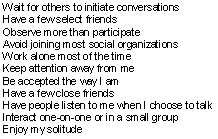 |
||
| 0 | Difference (See - Want) | I feel . . . | |
 |
 |
||
| Inclusion Exploration | |||
| What I GET from Other People | |||
| This aspect of Inclusion refers to what you Get from other people in terms of attention and being included and is measured by the People include me scale. Some people experience a high level of inclusive behavior from people, while others may experience a low level of inclusion. The complement to this aspect of Inclusion is how much you actually want people to include you, and this is measured by the I want people to include me scale. Some people find that they are being included to the extent they want to be, while others may find they are being included more or less than they actually want to be and, consequently, may be experiencing a feeling of dissatisfaction in this area. | |||
| 0 | People include me | People . . . | Key Words |
 |
 |
 |
|
| 0 | I want people to include me | I want people to . . . | |
 |
 |
||
| 0 | Difference (See - Want) | I feel . . . | |
 |
 |
||
| Control Exploration | |||
| What I DO Toward Other People | |||
| This aspect of Control refers to what you Do toward others in terms of the amount of control you exhibit over them and is measured by the I control people scale. Some people are more comfortable when they are in charge of people. They like to be the boss, to give orders and to make decisions for both themselves and others. To this end, they expend a lot of effort to be in charge while others may feel little obligation to do so. The complementary scale to this aspect of Control is how much you actually want to control people, and it is measured by the I want to control people scale. Some people find that they are controlling people to the extent they want to, while others may find they are controlling people more or less than they actually want to. Consequently, they may be experiencing a feeling of dissatisfaction in this area. | |||
| 0 | I control people | I . . . | Key Words |
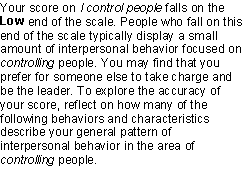 |
 |
 |
|
| 0 | I want to control people | I want to . . . | |
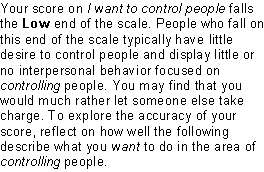 |
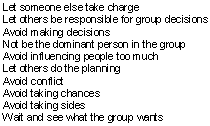 | ||
| 0 | Difference (See - Want) | I feel . . . | |
 |
 |
||
| Control Exploration | |||
| What I GET from Other People | |||
| This aspect of Control refers to what you Get from others in terms of the amount of control they exhibit over you and is measured by the People control me scale. Some people experience a high level of control behavior from people while others may experience a low level of control. The complementary scale to this aspect of Control is how much you actually want others to control you, and it is measured by the I want people to control me scale. Some people find that they are controlled by people to the extent they want to be, while others may find they are controlled more or less by others than they actually want to be. Consequently, they may be experiencing a feeling of dissatisfaction in this area. | |||
| 0 | People control me | People . . . | Key Words |
 |
 |
 |
|
| 0 | I want people to control me | I want people to . . . | |
 |
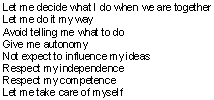 |
||
| 0 | Difference (See - Want) | I feel . . . | |
 |
 |
||
| Openness Exploration | |||
| What I DO Toward Other People | |||
| This aspect of Openness refers to what you Do toward others in terms of sharing your feelings and innermost thoughts during your interactions and is measured by the I am open with people scale. Some people readily share their feelings and personal thoughts with people around them. Others only share with a select few and, even then, may not share everything. The complementary scale to this aspect of Openness is how much you actually want to be open with people which is measured by the I want to be open with people scale. Some people find that they are open with people to the extent they want to be, while others may find they are more or less open than they actually want to be and, consequently, may be experiencing a feeling of dissatisfaction in this area. | |||
| 5 | I am open with people | I . . . | Key Words |
 |
 |
 |
|
| 5 | I want to be open with people | I want to . . . | |
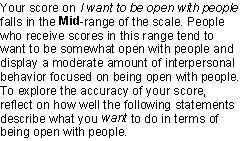 |
 |
||
| 0 | Difference (See - Want) | I feel . . . | |
 |
 |
||
| Openness Exploration | |||
| What I GET from Other People | |||
| This aspect of Openness refers to what you Get from others in terms of their sharing feelings and innermost thoughts with you in your interactions with them and is measured by the People are open with me scale. Some people readily share their feelings and personal thoughts with you. Others may not share anything. The complementary scale to this aspect of Openness is how much you actually want people to be open with you which is measured by the I want people to be open with me scale. Some people find that people are open with them to the extent they want them to be, while others may find people are more or less open than they actually want them to be and, consequently, may be experiencing a feeling of dissatisfaction in this area. | |||
| 3 | People are open with me | People . . . | Key Words |
 |
 |
 |
|
| 3 | I want people to be open with me | I want people to . . . | |
 |
 |
||
| 0 | Difference (See - Want) | I feel . . . | |
 |
 |
||
| Team Atmosphere | ||
| What I prefer in a team | ||
| Research indicates that team members are happier and more effective on teams when there is high team compatibility. Compatibility is defined as the ability to work well together to achieve a common goal. It does not imply liking or not liking, friendship or no friendship, agreement or disagreement. Those are factors independent of compatibility. Element B scores on inclusion, control and openness provide a means for determining atmosphere compatibility. The term atmosphere refers to the working environment and approaches to decision making. Your compatibility scores indicate the type of team “atmosphere” in which you are likely to be most effective. The atmosphere is composed of shared behavior, beliefs, values and settings and may incorporate different levels and types of inclusion, control and openness. (For more extensive treatment of the FIRO approach to teamwork, see Schutz, 1994.) | ||
| 0 | Inclusion |
Alone (0) Together (36) Together (36)
|

|
||

|
||
| 0 | Control |
Flow (0) Hierarchical (36) Hierarchical (36)
|

|
||

|
||
| 16 | Openness |
Businesslike (0) Personal (36) Personal (36)
|

|
||

|
||
| Leadership | ||
| How I am perceived as a leader | ||
|
Research indicates that there is no one style or pattern of
leadership behavior that is successful in all situations.
Successful leaders seem to be people who: • Know what it takes for the team to accomplish its goals • See to it that the team works to the best of its abilities • Select the best people to do each job • See to it that people most affected by a decision participate in making it To accomplish the above requires the leader to excel in at least three areas: • Flexibility: the ability to flex on inclusion, control and openness • Decision making: adopting the appropriate decision making model and making timely decisions • Self-Awareness: knowing how best to use myself and be aware of when I am feeling threatened, competitive, attracted, or experiencing other feelings that might distort my perceptions What the leader does in the areas of inclusion, control and openness while in the leader position creates a perception by the team members of “how” the leader leads. Your Do score suggests a leader who might be perceived as wanting: |
||
| 0 | Inclusion |
Alone (0) Together (9) Together (9)
|

|
||
| 0 | Control |
Flow (0) Hierarchical (9) Hierarchical (9)
|

|
||
| 5 | Openness |
Businesslike (0) Personal (9) Personal (9)
|

|
||
| Resources | ||
| Recommended Readings | ||
| Schutz, W. (1960). FIRO: A Three-Dimensional Theory of Interpersonal Behavior. New York: Rinehart. | ||
| Schutz, W. (1973). Elements of Encounter. New York: Irvington Publisher, Inc. | ||
| Schutz, W. (1979). Profound Simplicity. New York: Bantam. | ||
| Schutz, W. (1984). The Truth Option. Berkeley, CA: Ten Speed Press. | ||
| Schutz, W. (1989). Joy: Twenty Years Later. Berkeley, CA: Ten Speed Press. | ||
| Schutz, W. (1992). Beyond FIRO-B – Three New Theory-Derived Measures – Element B: Behavior, Element F: Feelings, | ||
| Element S: Self. Psychological Reports, 70, 915-937. | ||
| Schutz, W. (1994). The Human Element. San Francisco, CA: Jossey-Bass Publishers. | ||
| Thompson, H. (2000). Introduction to Element B in Organizations. Watkinsville, GA: Wormhole Publishing. | ||
| Recommended Training | ||
| The Human Element Seminar (Will Schutz Associates - 800.462.5874) | ||
| Element B Certification (High Performing Systems, Inc. - 800.535.8445) | ||
| Recommended Websites | ||
| www.firo.net | ||
| www.hpsys.com | ||
|